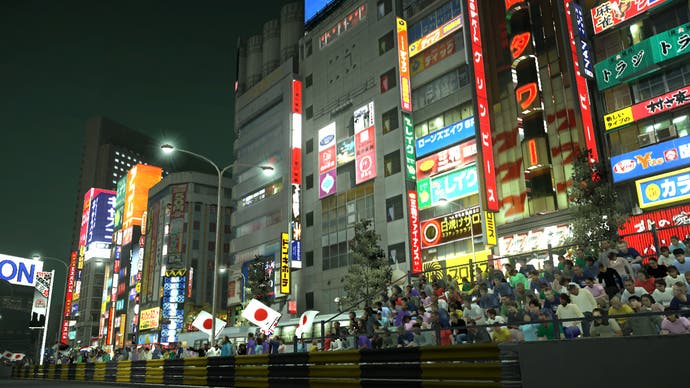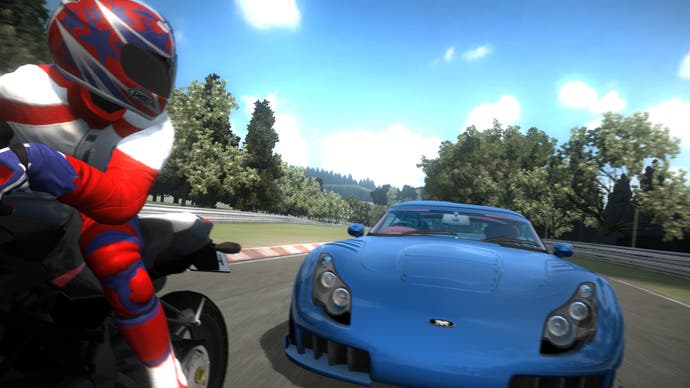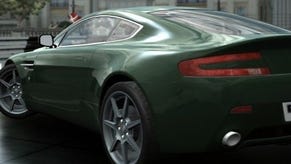Project Gotham Racing 4
Got ham?
Last time we saw PGR4, we had to sit across the room from it while two of the developers did endos and talked about puddles. What we actually wanted to do was drag them out by the hair, lock ourselves in and then try and get ALL PLATINUMS for as long as it took Kevin Spacey to convince us to open the door again. So this time we did just that. Close enough, anyway.
We went to Bizarre's studio in Liverpool, where we learned many things. For instance, a bottle of vodka they stole from Sony is more important to everyone than the PGR2 BAFTA, and therefore sits in a nicer cabinet. For even more instance, PGR4 is so big that the Arcade mode alone has more events in it than the whole of PGR3. "It's a monster!" bellows Gareth Wilson, design manager. "What have we done!" What they have done is split the game into a hardcore medal-hunt and a gentler, more varied procession of races.
Career mode is the latter - a calendar of events set out as a season, with multi-race championships sprinkled across each month along with "major events" (where the game wheels out its best AI) and invitationals, which give you the opportunity to win cars exclusive to those events. Events that consist of more than one stage are decided by overall Kudos points, with a certain amount handed down for a win and added to your (smaller) total of Kudos earned in-game - in some cases enough to sneak up a place, presumably, but no substitute for actually being good.
Progress in Career, however, isn't about winning a certain amount of medals, but climbing up a 72-slot leaderboard from a rank amateur to a master. This in turn unlocks new events at different ranks. And instead of picking your difficulty level pre-race, you now set one for the entire Career season. It's a structure that has more in common with something like TOCA Race Driver than PGR3.

Fortunately, Arcade mode is there for those of us who like sitting in front of the TV doing the same task 58 times in a row to get the best medal. With 128 medals in total, it dwarfs PGR3, and allows you to compete at Steel, Bronze, Silver, Gold and Platinum level on a per-event basis. Some events are locked to cars or to bikes, but most offer a car medal and a bike medal, allowing you to pick the one you want to do.
Naturally we're drawn to Arcade mode, and have a quick scan to see what's on offer. The opening events include street races, breakthroughs (clear a certain number of checkpoints before the time runs out), timed runs (finish within time limit), hot laps (better a prescribed lap-time), overtake challenges (overtake X amount of cars) and elimination (last-placed driver eliminated at the end of each lap).
New or altered are the speed challenge, which used to involve simply going through one speed-trap at the highest speed possible, but now strings several speed-traps together, making it harder to fluke; along with cone attack and cone sprint. The latter is the traditional cone challenge of older games, while cone attack is about running into triangles of cones, bowling-style, to try and topple as many as your target medal requires before the clock runs down.
The key question, of course, is whether it's properly balanced. The back half of PGR3 simply wasn't - the Nurburgring finishers were easier than some of the stuff you did in hour three - but Bizarre insists that the lack of a pressing console or service launch has given them more time to finish up. Picking a task at random (so, cone sprint) and hopping in a random BMW, we set about trying for platinum to see how they've done.

Our first attempt sees us topple a couple of cones accumulating penalty seconds that eventually bring us home 17 seconds over the time limit. Whoops. Of course, we were just getting our eye in, which is why on our third (perhaps fourth) attempt, we manage to sneak it home (alright, fifth) with two hundredths of a second to spare. We didn't manage the whole track as one Kudos chain, but we did avoid hitting any cones. Interestingly, the medal requirement is overall time rather than Kudos. Unless the nine hours I had to spend on a train in one day is making me remember it wrongly.
One of the reasons Bizarre split the game into Career and Arcade thus is the belief that PGR games were always a bit "dry". Sort of sterile. The crowds weren't particularly animated and the tracks were all a bit 28 Days Later. With this in mind, the team decided to "humanise" PGR and bring it to life. To achieve that, the first thing they did was give you more character - you pick whether you're a boy racer or a girl racer, you pick your nationality (and don't lie - there'll be tournaments specific to your country), as well as basic distinguishing characteristics like helmet and visor colour and what sort of clothes you wear.
For a bit more customisation, you can also edit your car's paint-job. Don't get too excited - it's not Forza's car editor for PGR. Instead, you create a pattern that - by selecting a little spray-can icon when you choose vehicle colour - outfits whatever you drive in a distinctive livery, like wrapping a football shirt around different bodies.
Not only that, of course, but they threw in the vaunted weather effects, which we've dealt with in some depth already. "Weather shouldn't be something you fear," Wilson tells us. "It should be something you look forward to". Graphically, it certainly will be. Tokyo in the rain is "mean, dark, Blade Runner-esque", and Nurburgring in the snow is, well, beyond adjectives [that's cheating - Ed]. And of course ice patches and puddles influence the racing line, but to make things more fun, not to hinder.



